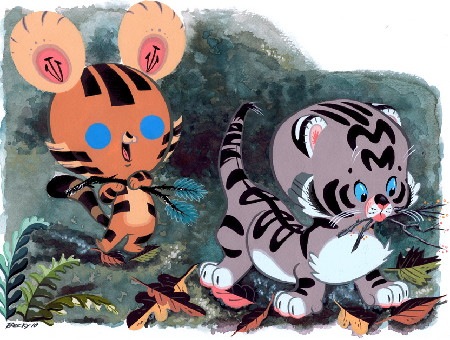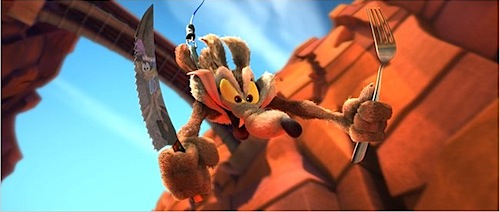§ Frank Miller is blogging again! [Via JK Parkin]
How, then? How to make a comic book something more than a puny imitation of film, or worse, wannabe prose with a bunch of drawings that don’t belong there? What is it that gives certain comics an appeal unlike any other medium? Why can some cartoonists get you to spend just the right stretch of moments, just long enough, on each drawing? Skipping past the dirty tricks of the trade, since cartoonists have to keep their secrets, the best and most legitimate way to get the all-powerful reader to surrender his power over time is to seduce the reader. To charm the reader. We are, after all, pleasure-driven creatures, pulled toward what charms us. We don’t hurry past what charms us.
§ We did not properly note Top Shelf’s Brett Warnock’s report on Stumptown and TCAF , but he did say that Becky Dreistadt does not get mentioned enough and he is totally right. Becky Dreistadt.
§ A Toronto newspaper columnist ate dinner with Jim Rugg and Matt Kindt and wrote about them eating food — oh, and about their books, too.
§ Comic strip artists wistfully imagine a world where the iPad has rescued the comic strip.
§ Brooks Barnes in the NY Times has a large article on Warner’s attempts to beef up the Looney Tunes brand, with regard to their plan to make new Looney Tunes cartoons. The story is full of interesting Bunny factoids, and also takes lots of time to trash Loonatics, as must be done in order for the healing to begin:
Improving the quality will not be difficult. “The bar had gone so low that we could only go up,” said Sam Register, who took over as executive vice president of creative affairs at Warner Brothers Animation two years ago, referring to previous efforts to reimagine Looney Tunes for a new generation.
Warner has a reputation, both with fans and inside the industry, for ham-fisted campaigns to breathe new life into the franchise. Steven Spielberg sparked things up in the early 1990s with “Tiny Toons Adventures,” a series in which new characters interacted with the originals. But a 2002 effort, “Baby Looney Tunes,” was a dud for the former WB network and later for the Cartoon Network.
Most satisfyingly, the pieces notes that Cartoon Network programming head Sam Register keeps art from Loonatics — the extremely painful attempt to give the Looney Tunes characters futuristic makeovers — as a reminder of “what not to do”, and also a mention that Looney Tunes merch sales have been sliding for about eight years, although they still weigh in at a healthy $1 billion a year. I said, I said, $1 billion, son.
The crew at Cartoon Brew chews over this story at length and a few folks suggest that the best way to rebuild the brand is not by making new, crappy cartoons, but by making the old classics more available.
Despite the general mistrust of contemporary efforts, this CGI version of Wile E. Coyote won some approval since it does look very cool.






I think it’s a great shame that WB has never figured out how to properly bring the Looney Tunes into modern times. I’ve had many conversations with WB executives that indicated that they had no idea what the characters even mean, much less how to make them live again. The idea of putting them in a suburban cul-de-sac doesn’t sound like the right solution. What I remember from my childhood was The Bugs Bunny Show or whatever they called it, where the shorts were presented as some sort of vaudeville show with linking bits between. That seemed fine to me, kind of like The Muppet Show — it’s not “about” anything, it’s a show, about characters who are, first and foremost, creatures of show business.
Todd Alcott wrote, “I’ve had many conversations with WB executives that indicated that they had no idea what the characters even mean, much less how to make them live again. The idea of putting them in a suburban cul-de-sac doesn’t sound like the right solution.”
Yeah, that sounds too much like where Disney went wrong with Mickey Mouse back in the 1950s. He became just another suburbanite and lost all of his wit and bite. Didn’t the LOONEY TUNES newspaper strip follow this pattern for a time? I don’t remember seeing it a lot of papers. Maybe that should be telling those execs something.
You know what, your posts are usually a good read, but this time around – for me anyway I feel like it is put together a little hasty.I may be wrong about that, but this one just doesn’t flow like other posts. Sorry about that.